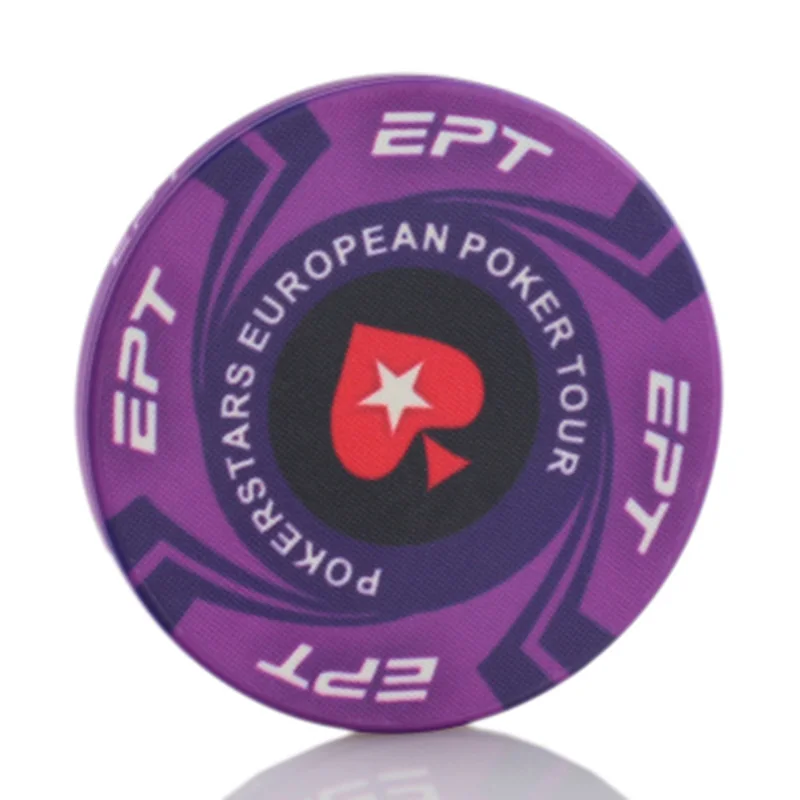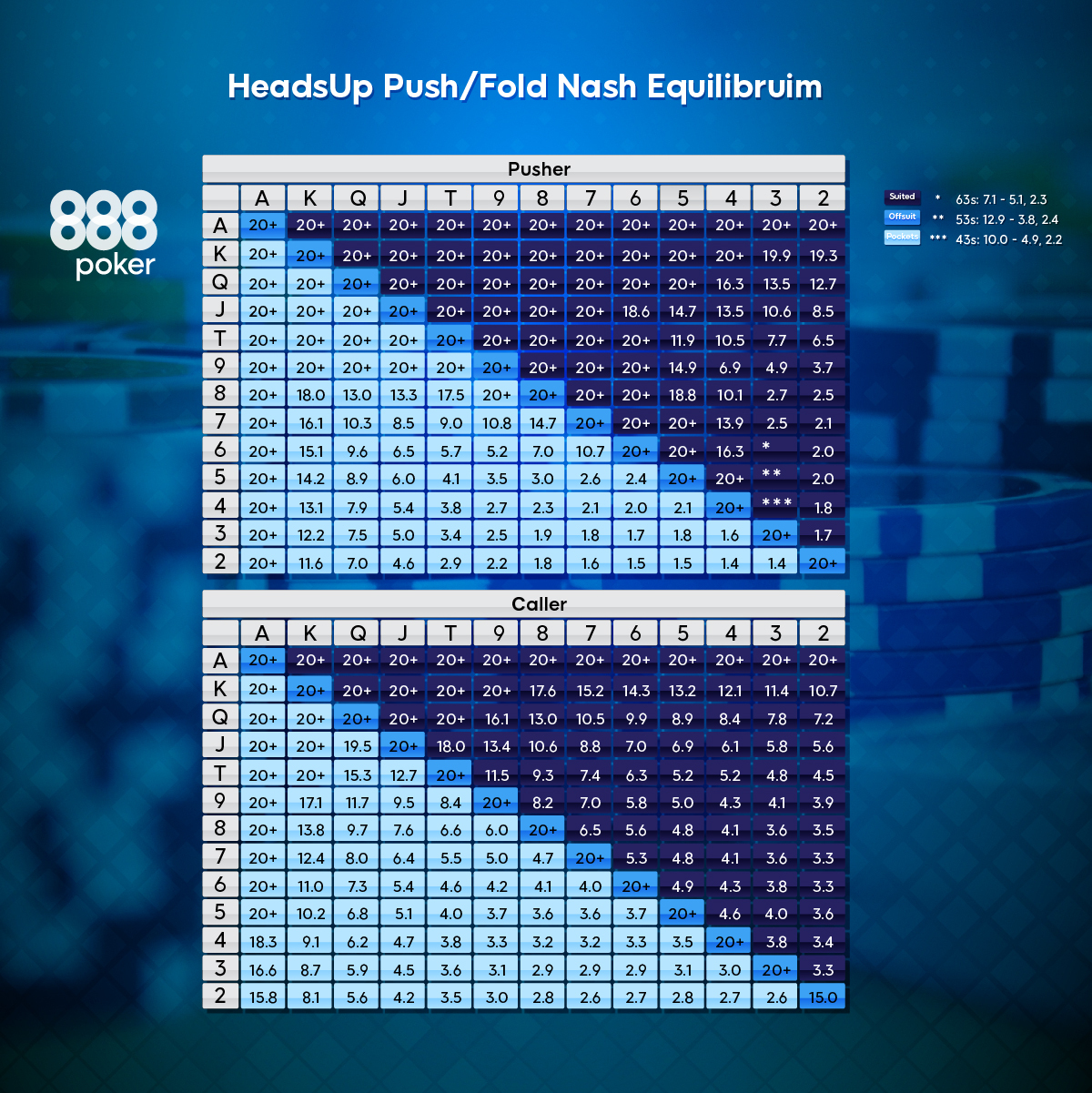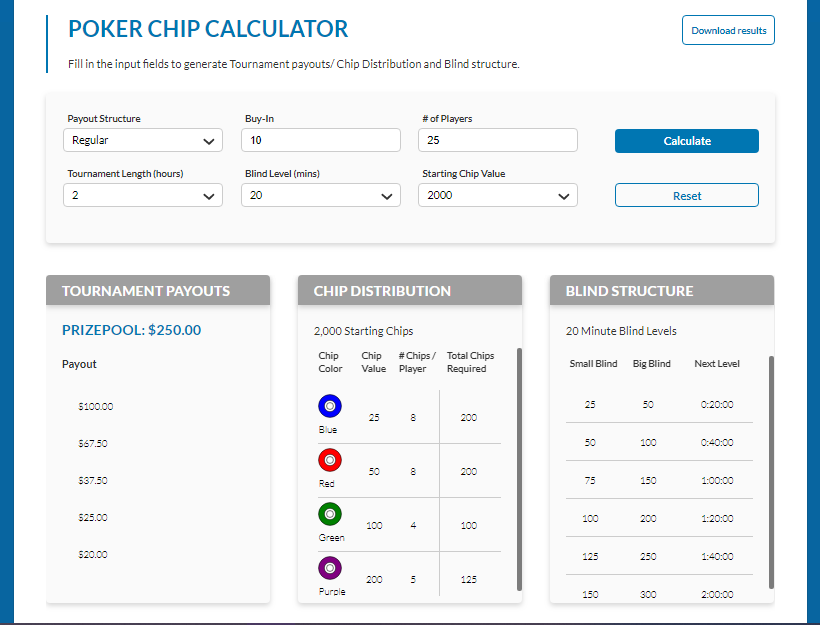Poker Tournament Starting Chips Calculator
The blind calculator tool below can take care of that and help set up your perfect structure. To calculate a blind structure, you need the starting blind level, the estimated total value of the tournament chips in play (initial buy-ins plus rebuys and add-ons) and the desired length of the tournament. When starting the tournament, make sure that each player has enough chips. Have at least 20 chips of smallest denomination. For example, when starting with $5000, your blinds start at $25-$50; have at least 20 green $25 chips. The reason for this is that a player won’t run out of the small denomination chips.
- Poker Tournament Structure Calculator
- Poker Tournament Starting Chips Calculator Online
- Poker Tournament Starting Chips Calculator 2019
- Poker Tournament Payout Calculator
Being a supplier of poker chips we are often asked what a good breakdown is for a poker game. Our immediate response is normally, “it depends”. Is it a cash game or tournament? How many chips do your players like to have in front of them? Do you ever see your stakes rising in the future? How deep do your players get by the end of the night?
Dia de los Muertos poker chips
There are many factors to consider when figuring out a breakdown of chips for your poker game. Make sure to consider them all. Take some time and work out your breakdown in writing so you can visualize the chips being used.
Let’s consider a poker game that is only a tournament. This is the most common type of game that is being played in home games.
Try to not think about just how many “chips” that a player starts with. You can have a player start with 100,000 chips but if the blinds are 1000/2000 in the first level they will have shorter stacks compared to a player that starts with 5000 chips with the first blinds being 25/50. In the first situation the player starts with 50 big blinds while in the second situation the player starts with 100 big blinds. That is a big difference!
So, try to think about how many big blinds (BB) you want each player to start with. A good rule of thumb is that most tournaments start with 50-100 BBs but some players prefer deep-stack tournaments that start with 100+ BBs.
Now, consider how many actual physical chips you want each player to start with. Most players like to have a HUGE stack in front of them, but you have to realize that players need to start with a smaller stack or else you will have to purchase a very large number of chips. In a normal home game tournament players will start with 20-30 chips.
Tournament
Finally, consider how many players you will have in your tournaments and how long the tournament will normally last. If there are a lot of players (20+ players) it will mean that there will be a lot of initial chips on the tables. There will be so many chips that you will have to “color up” the lower denomination chips at some point during the tournament. So, you will need to have higher denomination chips than the initial starting poker chips.
Let’s look at an example set up:
Total players: 20
Starting blinds: 25/50
Starting stack: 5000 (100 BB)
Number of poker chips to start with: 21
Initial chips that each player has in front of them:
- 4 – “25” chips = 100
- 9 – “100” chips = 900
- 8 – “500” chips = 4000
Starting stack of our Nevada Jack Skulls poker chips.
Total number of physical poker chips to start with: 21 X 20 = 420 poker chips At some point during the tournament the “25” chips will be useless since the blinds will be in even “100’s”. At that point you can “color up” the “25” chips. So, you will need more “100” and possibly more “500” chips. So, it is suggested that another 20 “100” chips be added.
At some point during the tournament the “25” chips will be useless since the blinds will be in even “100’s”. At that point you can “color up” the “25” chips. So, you will need more “100” and possibly more “500” chips. So, it is suggested that another 20 “100” chips be added.Extra “100” chips for coloring up during the tournament:
- 20 – “100” chips
This brings the total chips needed for this game to 440 poker chips. At this point it is suggested that extra chips are added for a few reasons. Maybe you will have a game where 22 people show up. Some chips may get lost over time, etc.
Extra chips for special circumstances:
- 30 – “25” chips
- 20 – “100” chips
- 10 – “500” chips
This brings the total count of chips to:
- 110 – “25” chips
- 220 – “100” chips
- 170 – “500” chips
- 500 total poker chips
That is a general overview of how to figure out what poker chips to get for a tournament. Let’s discuss a cash game since this will be a bit different.
Cash Game
It is understood that cash games can vary drastically in stakes. Therefore, let’s not focus on the actual value of the chips but think in terms of big blinds (BB’s). I will discuss a $1/2 NL Holdemgame, but will mention BB’s.
The difference with a cash game is that players are often able to rebuy many times. Also, in many games the buy-in is not capped so a player can typically buy-in for 50 BB’s, 100 BB’s, 200 BB’s, or sometimes much higher. So, by the end of a game the value of chips can far exceed what you start with. However, home cash games generally do not involve more than 10 players.
Let’s consider an uncapped $1/2 NL Holdem game that has unlimited rebuys.
On average, the initial buy-in may be 100 BB’s per player ($200). So, let’s figure out the starting chips for each player:
- 15 - $1 chips = $15
- 17 - $5 chips = $85
- 4 - $25 chips = $100
- Total – 36 chips = $200
This brings the total number of chips starting out on the table to 360 poker chips (36 X 10 players).
As mentioned, players will often rebuy (sometimes many times) and players may be allowed to buy-in for more than 100 BB’s. This means we have to consider the extra poker chips needed for the game.
The starting value of the chips on the table is $2000 (10 players X $200).
During a typical game, the total value chips at the end of the game will be 2-3X the starting value. So, let’s figure out the extra chips needed if the value is up to 3X the starting value:

- 100 - $5 chips = $500
- 20 - $25 chips = $500
- 10 - $100 chips = $1000
Poker Tournament Structure Calculator
This brings the total chips needed to (490 = 360 + 130).
As with the tournament, it is best to add extra chips for the situations where the game gets very deep. You also may want to prepare for if the game grows into a higher stakes game such as $2/5.
Here is a suggestion for extra chips that will cover deep games and slightly higher stakes:

- 80 - $25 chips = $2000
- 30 - $100 chips = $3000
Also, consider adding extra poker chips for the occasional lost chip:
- 50 - $1 chips
- 50 - $5 chips
As you can see, with the cash game there are more poker chips to purchase. This is often the case, but you are also prepared for a deep game and for future games when the stakes move up. For this situation the total poker chips suggested is (490 + 120 + 100 = 700).
There are no rules regarding the poker chips needed for a game. You may find that your games don’t need as many poker chips or you prefer to have more. The most important thing is to write out what chips you think you need. Try to break down your game like the examples above. It is much better to be prepared before your game starts than to find out that you do not have the poker chips you need to run the game.
What are poker blinds ?
Based on the limit of the poker game the player to the left of the dealer’s button (small blind) and the player two to the left of the dealer (big blind) are required to place mandatory bets in the pot before cards are dealt (Small blind has to put half of the big blinds amount). These bets count toward the first round of betting. So if the pot is not raised pre-flop, small blind will only have to put half a bet to call and big blind has the option of raising or just checking.
In a poker tournament, blinds go up gradually. This is to ensure that the tournament finishes on a timely manner. (the higher the blinds get the more players tend to get eliminated).
Blinds usually go up after predetermined periods of time. (for example every 15 or 20 minutes).
Two main factors determine blind structure of the game:
- Starting chip amount
- How long you want the tournament to last.
Poker Blind Structure Tips
Poker Tournament Starting Chips Calculator Online
- The first big blind should be 1/50 of the starting chip amount. (or the starting chip amount should be 50 times the starting big blind). So if everyone starts with 1000 in chips the first big blind should be 10/20.
- Blind period is the time each blind lasts:
- Typical tournament blind periods are 10, 15, 20, 30, or 60 minutes.
- Blinds period should be the same for every blind.
- The faster the blind period is the faster the tournament ends and the more luck involves. So it’s a good idea to have slightly longer blind periods at your house game. 15 or 20 minute blind periods are good choices. Blinds in online websites tend to go up faster. This is because online poker action is much faster than live poker.
- Blinds typically double after each round. If the first big blind is 10/20, the next one should be 20/40.
Calculate Blind Structure
Follow these simple steps to create blind structure that best fits your game:
- Decide your starting chip amount.
- Divide it by 50. This should be your first big blind.
- Make your final big blind (when the tournament should finish) equal to your starting chip amount.
- Arrange the middle level blinds so that they gradually increase from your first big blind to the last one. It is best to keep the first couple blind periods low.
- Add the period (times) together. If it seems too long takes couple levels off the chart, and if it seems short add couple level to the chart.
Sample Tournament Blind Structure Chart
Following is a chart of recommended blind structures based on different starting chip stacks :
Poker Tournament Starting Chips Calculator 2019

Poker Tournament Payout Calculator
| Blind Period | Chip Stack | |||
| 100 | 1000 | 2500 | 5000 | |
| 1 | 1/2 | 10/20 | 25/50 | 50/100 |
| 2 | 2/4 | 20/40 | 50/100 | 100/200 |
| 3 | 3/6 | 30/60 | 75/150 | 150/300 |
| 4 | 5/10 | 50/100 | 100/200 | 200/400 |
| 5 | 10/20 | 75/150 | 200/400 | 300/600 |
| 6 | 15/30 | 100/200 | 300/600 | 500/1000 |
| 7 | 25/50 | 150/300 | 500/1000 | 750/1500 |
| 8 | 50/100 | 200/400 | 750/1500 | 1000/2000 |
| 9 | 75/150 | 300/600 | 1000/2000 | 1500/3000 |
| 10 | 100/200 | 400/800 | 1500/3000 | 2000/4000 |
| 11 | 150/300 | 500/1000 | 2000/4000 | 3000/6000 |
| 12 | 200/400 | 1000/2000 | 2500/5000 | 5000/10000 |